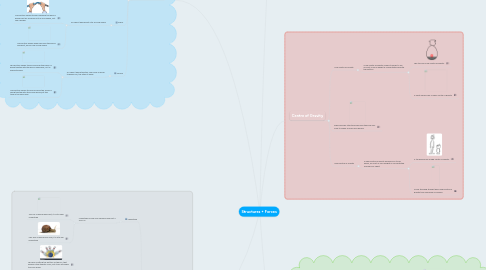
1. Internal Forces
1.1. Compression
1.1.1. Two objects pushing themselves together
1.1.1.1. This person walking shows compression because they are stepping on the ground/squishing it.
1.1.1.2. This person writing shows compression because they are pushing a pencil against the paper.
1.2. Tension
1.2.1. An object being pulled opposite ways, or being stretched
1.2.1.1. This picture shows tension because it is being ripped, it will only be ripped because someone is pulling it in opposite directions.
1.2.1.2. This picture shows tension because, the rope is being pulled 2 ways. The rope will eventually rip because it is under too much tension.
1.3. Shear
1.3.1. An object being bent into an arch shape
1.3.1.1. This picture shows tension because the pipe is being bent by someone into a arch shape, just like a bridge.
1.3.1.2. This picture shows shear because the spoon was bent, and is now a arch shape.
1.4. Torsion
1.4.1. An object being twisted, one force is going towards you, the other is away
1.4.1.1. This picture shows torsion because the pencil is being twisted with the pencil sharpener, but in opposite ways.
1.4.1.2. This picture shows torsion because the screw is being twisted with the screw driver,but this time in the same way.
2. Application of Force
2.1. Magnitude
2.1.1. Magnitude is how you measure how fast a force is
2.1.1.1. This car is going really fast, it is at a high magnitude
2.1.1.2. This snail is going very slow, it is at a low magnitude
2.2. Point of Application
2.2.1. Where you apply the force
2.2.1.1. This ball is hitting the bottom of the pin, that weakens the stability more, but it will be harder to knock down
2.2.1.2. This wrecking ball is hitting the middle of the building
2.3. Direction of Force
2.3.1. Push or Pull
2.3.1.1. This figure is pushing a box
2.3.1.2. This figure is pulling a cart
2.4. Plane of Application
2.4.1. Which way you are applying the force
2.4.1.1. The wall is being hit from the front (90 degrees)
2.4.1.2. This football player is being hit from the side (180 degrees)
3. Loads
3.1. Static Load
3.1.1. Dead Loads
3.1.1.1. An object that doesn't move from where it is
3.1.1.1.1. A building is a dead load because it stays in one spot, even if anything around it is moved
3.1.1.1.2. The pacific ocean is a dead load, because it stays in one spot, and there are millions of live loads in it
3.1.2. Live Load
3.1.2.1. An object that can be moved at anytime
3.1.2.1.1. This couch is portable and can be transported to anywhere
3.1.2.1.2. This banana can be eaten and moved to another fruit bowl
3.2. Dynamic Load
3.2.1. A force that can affect a live or dead load
3.2.1.1. A tsunami can affect buildings with the extreme magnitude and size of the wave
3.2.1.2. Lightning can cause flame to flammable items, so it will affect live loads and maybe dead loads
4. Types Of Structures
4.1. Shell Structure
4.1.1. A hollow structure that is fragile
4.1.1.1. Mugs are a shell structure because since it is made of glass it is easily broken. Another reason why is because it's hollow.
4.2. Frame Structure
4.2.1. A structure with parts joined together; very flexible
4.2.1.1. A spiderweb is a frame structure because it has many joined parts in it.
4.2.1.2. A car frame is a frame structure because it has many metal pieces joined together.
4.3. Solid Structure
4.3.1. An un-flexible structure with no inside
4.3.1.1. This magnet is a solid structure because it is not hollow and it cannot be bent.
4.3.1.2. A brick is a solid structure because it is un-flexible structure without anything inside of it.
4.4. Combination Structure
4.4.1. A structure with at least 2/3 of the typed built in it
4.4.1.1. A house is hollow, sturdy, and has wood frames in it
4.4.1.2. A car is sturdy, hollow, and built with frames too
5. Centre of Gravity
5.1. Low Centre of Gravity
5.1.1. A low centre of gravity makes it harder to fall, as most of your weight is concentrated around the bottom
5.1.1.1. This toy has a low centre of gravity
5.1.1.2. A short person has a lower centre of gravity
5.2. Eggs are shell structures because they are very easy to break. And are also hollow.
5.3. High Centre of Gravity
5.3.1. A high centre of gravity enables you to fall easier, as most of your weight is concentrated around your chest
5.3.1.1. A tall person has a high centre of gravity
5.3.1.2. Some standing straight has a high centre of gravity than someone crouching

